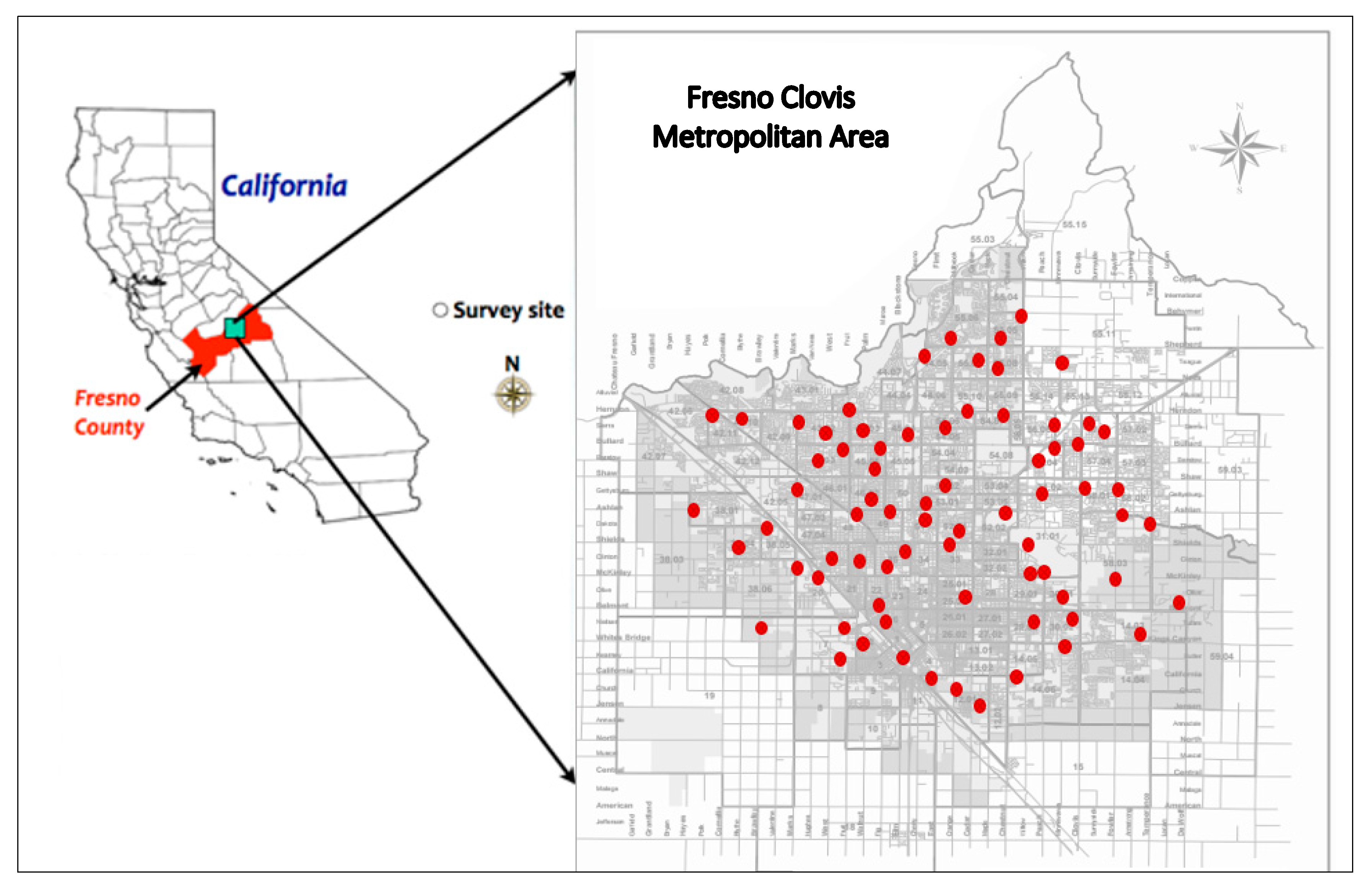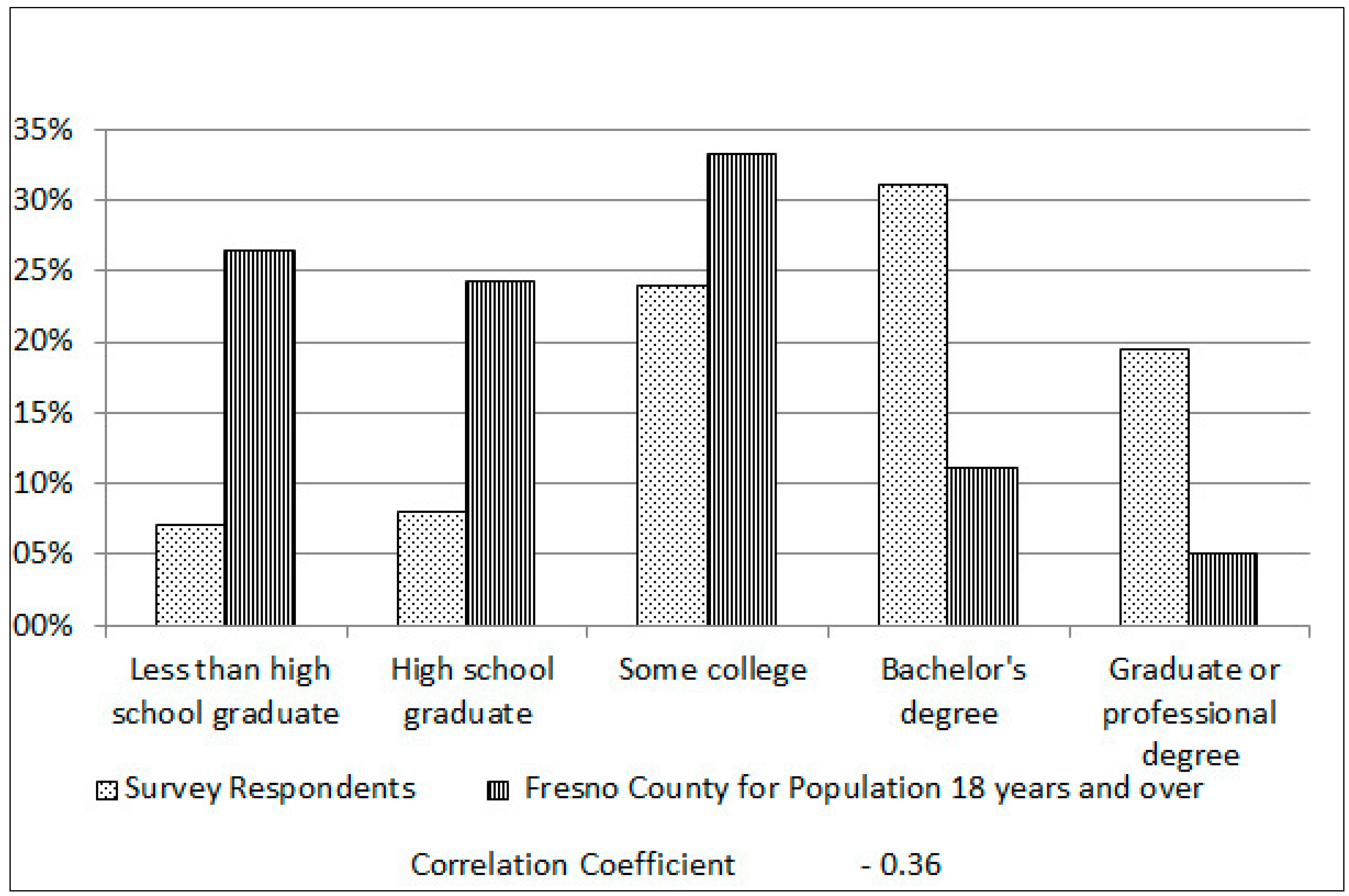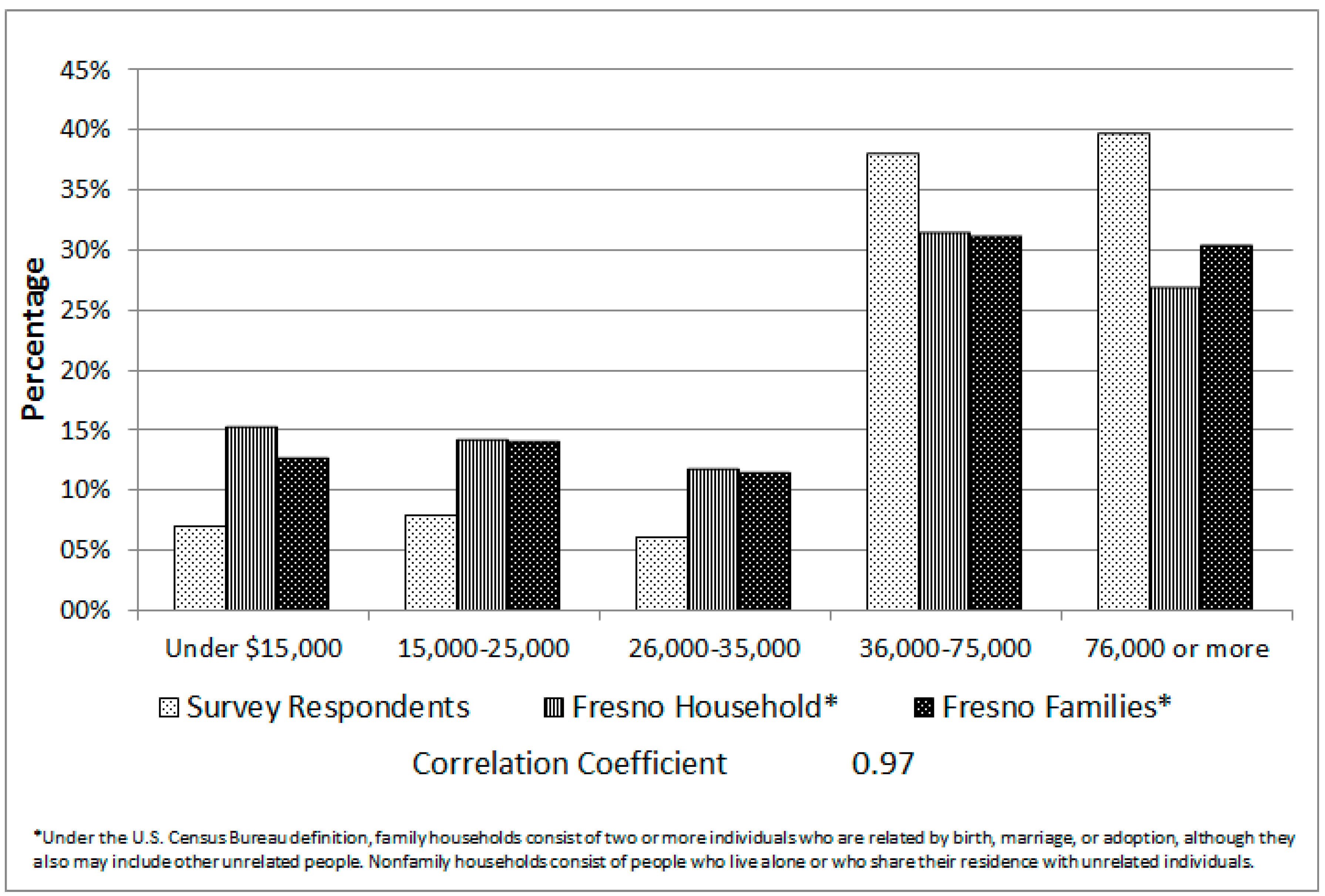The Influence of Structural Conditions and Cultural Inertia on Water Usage and Landscape Decision-Making in a California Metropolitan Area
Abstract
:1. Introduction
Theoretical Context
2. Materials and Methods
2.1. Sampling
2.2. Social Survey
Questionnaire Contents
2.3. Site Visits
2.4. Focus Group Interviews
3. Results
3.1. Mail Questionnaire
3.1.1. Demographics
3.1.2. Outdoor Water Use
3.1.3. Water Policies in the Neighborhood
3.1.4. Decision-Making Involving Water Use
3.2. Site Visits
3.2.1. Conservation: Preference and Behavior
3.2.2. Aesthetics
3.2.3. Function
3.2.4. Cost/Benefit Uncertainties
3.2.5. Structural Effects and Neighborhood Regulation
3.3. Focus Group Interviews
- All participants had grass yards, and asserted that such yards were best for children (to play upon, etc.).
- Eleven of the 12 participants in the first two groups did not have an aesthetic appreciation of low water landscaping.
- Seventeen out of 18 participants were reluctant to change from turfgrass lawns to low water landscaping, but did express an interest in attaining information on water metering, low water use plants, the water savings that xeriscaping would provide, and what incentives the state or city would provide to change their lawns. Those 17 indicated they would switch to low water landscaping if the price of water became unaffordable due to metering.
- None of the participants expressed interest in wildlife or environmental conservation, but over one third expressed fear regarding an increase in the presence of what they described as hostile insects (i.e., wasps, bees, and ants).
4. Discussion
Supplementary Materials
Acknowledgments
Author Contributions
Conflicts of Interest
References
- Kundzewim, Z.W. Some for all, forever—Sustainable development and management of water resources. Int. J. Sustain. Dev. World Ecol. 2001, 8, 290–298. [Google Scholar] [CrossRef]
- Diamantini, C.; Zanon, B. Planning the urban sustainable development: The case of the plan for the province of Trento, Italy. Environ. Impact Assess. Rev. 2000, 20, 299–310. [Google Scholar] [CrossRef]
- Deniz, B.; Eşbah, H.; Küçükerbaş, E.V.; Şirin, U. Analysis of vegetation structure in urban land uses: Case of the City of Aydın. Ekoloji 2008, 17, 55–64. [Google Scholar] [CrossRef]
- Dong, R.; Xu, H.; Gou, Y.; Fu, X.; Gang, W. Analysis of land-use scenarios for urban sustainable development: A case study of Lijiang City. Int. J. Sustain. Dev. World Ecol. 2011, 18, 486–491. [Google Scholar] [CrossRef]
- Alig, R.J.; Kline, J.D.; Lichtenstein, M. Urbanization on the US landscape: Looking ahead in the 21st century. Landsc. Urban Plan. 2004, 69, 219–234. [Google Scholar] [CrossRef]
- Hope, D.; Gries, D.; Warren, P.; Katti, M.; Stuart, G.; Oleson, J.; Kaye, J. How do humans restructure the biodiversity of the Sonoran Desert? In Connecting Mountain Islands and Desert Seas: Biodiversity and Management of the Madrean Archipelago II; Gottfried, G.J., Ed.; USDA Forest Service, Rocky Mountain Research Station: Tucson, AZ, USA, 2004; pp. 189–194. [Google Scholar]
- Grimm, N.B.; Faeth, S.; Golubiewski, N.; Redman, C.; Wu, J.; Bai, X.; Briggs, J. Global change and the ecology of cities. Science 2008, 319, 756–760. [Google Scholar] [CrossRef] [PubMed]
- Graymore, M.L.M.; Wallis, A.M. Water savings or water efficiency? Water-use attitudes and behaviour in rural and regional areas. Int. J. Sustain. Dev. World Ecol. 2010, 17, 84–93. [Google Scholar] [CrossRef]
- Stead, D. Urban planning, water management and climate change strategies: Adaptation, mitigation and resilience narratives in the Netherlands. Int. J. Sustain. Dev. World Ecol. 2014, 21, 15–27. [Google Scholar] [CrossRef]
- Tyler, M.E.; Quin, M. A social-spatial approach to ecological governance. Int. J. Interdiscip. Soc. Sci. 2010, 5, 73–86. [Google Scholar] [CrossRef]
- Grimm, N.B.; Grove, J.M.; Pickett, S.T.A.; Redman, C.L. Integrated approaches to long-term studies of urban ecological systems. BioScience 2000, 50, 571–584. [Google Scholar] [CrossRef]
- Pickett, S.T.A.; Cadenasso, M.L.; Grove, J.M.; Nilon, C.H.; Pouyat, R.V.; Zipperer, W.C.; Costanza, R. Urban ecological systems: Linking terrestrial ecological, physical, and socioeconomic components of metropolitan areas. In Urban Ecology: An International Perspective on the Interaction between Humans and Nature; Marzluff, J.M., Shulenberger, E., Endlicher, W., Alberti, M., Bradley, G., Ryan, C., Simon, U., ZumBrunnen, C., Eds.; Springer: New York, NY, USA, 2008; pp. 99–122. [Google Scholar]
- Aksoy, Y. Examining the ecological quality of Küçükçekmece district parks in İstanbul in terms of permeability and natural vegetation. Ekoloji 2010, 19, 181–189. [Google Scholar] [CrossRef]
- Berk, R.A.; Cooley, T.F.; LaCivita, C.J.; Parker, S.; Sredl, K.; Brewer, M. Reducing consumption in periods of acute scarcity: The case of water. Soc. Sci. Res. 1980, 9, 99–120. [Google Scholar] [CrossRef]
- Hamilton, L.C. Saving water: A causal model of household conservation. Sociol. Perspect. 1983, 26, 355–374. [Google Scholar] [CrossRef]
- Mainieri, T.; Barnett, E.G.; Valdero, T.R.; Unipan, J.B.; Oskamp, S. Green buying: The influence of environmental concern on consumer behavior. J. Soc. Psychol. 1997, 137, 189–204. [Google Scholar] [CrossRef]
- Vickers, A. Handbook of Water Use and Conservation; Water Plow Press: Amherst, MA, USA, 2001. [Google Scholar]
- Princen, T.; Maniates, M.; Conca, K. Confronting Consumption; The MIT Press: Cambridge, MA, USA, 2002. [Google Scholar]
- Corral-Verdugo, V.; Bechtel, R.B.; Frijo-Sing, B. Environmental beliefs and water conservation: An empirical study. J. Environ. Psychol. 2003, 23, 247–257. [Google Scholar] [CrossRef]
- Hanak, E.; Browne, M.K. Linking housing growth to water supply. J. Am. Plan. Assoc. 2006, 72, 154–166. [Google Scholar] [CrossRef]
- Coleman, J.S. Foundations of Social Theory; Harvard University Press: Cambridge, MA, USA, 1990. [Google Scholar]
- Wallace, R.; Wolf, A. Contemporary Sociological Theory: Continuing the Classical Tradition, 3rd ed.; Prentice Hall: Upper Saddle River, NJ, USA, 1991. [Google Scholar]
- Smith, A. An Inquiry into the Nature and Causes of the Wealth of Nations; William Strahan: London, UK, 1776. [Google Scholar]
- De Oliver, M. Attitudes and inaction: A case study of the manifest demographics of urban water conservation. Environ. Behav. 1999, 31, 372–394. [Google Scholar] [CrossRef]
- Jowsey, E. The changing status of water as a natural resource. Int. J. Sustain. Dev. World Ecol. 2012, 19, 433–441. [Google Scholar] [CrossRef]
- Corral-Verdugo, V.; Frias-Armenta, M.; Perez-Urias, F.; Orduna-Cabrera, V.; Espinoza-Gallego, N. Residential water consumption, motivation for conserving water and the continuing tragedy of the commons. Environ. Manag. 2002, 30, 527–535. [Google Scholar] [CrossRef]
- Catenazzo, G.; D’Urso, J.; Fragnière, E.; Tuberosa, J. Influences of Public Ecological Awareness and Price on Potable Water Consumption in Geneva. In Climate Change and the Sustainable Use of Water Resources. Climate Change Management; Leal Filho, W., Ed.; Springer: Berlin, Germany, 2012. [Google Scholar]
- Morehouse, B.J. Climate impacts on urban water resources in the southwest: The importance of context. J. Am. Water Resour. Assoc. 2000, 36, 265–277. [Google Scholar] [CrossRef]
- Tinker, A.; Bame, S.; Burt, R.; Speed, M. Impact of “Non-Behavioral Fixed Effects” on Water Use: Weather and Economic Construction Differences on Residential Water Use in Austin, Texas. EGJ. 2005. Available online: http://escholarship.org/uc/item/7rh33286 (accessed on 26 September 2017).
- Corbella, H.M.; Pujol, D.S. What lies behind domestic water use? A review essay on the drivers of domestic water consumption. Bol. R. Acad. B. Artes San Fernando 2009, 50, 297–314. [Google Scholar]
- Bell, M. An Invitation to Environmental Sociology, 3rd ed.; Pine Forge Press: Thousand Oaks, CA, USA, 2009. [Google Scholar]
- Weber, M. Class, status and party. In From Max Weber: Essays in Sociology; Gerth, H., Mills, C.W., Eds.; Routledge and Kegan Paul: London, UK, 1924. [Google Scholar]
- Simmel, G. Fashion. In On Individuality and Social Forms; Simmel, G., Ed.; University of Chicago Press: Chicago, IL, USA, 1971; pp. 294–323. [Google Scholar]
- Veblen, T. The Theory of the Leisure Class; MacMillan Publishers: London, UK, 1899. [Google Scholar]
- Simmel, G. The metropolis mortal life. In On Individuality and Social Forms; Simmel, G., Ed.; University of Chicago Press: Chicago, IL, USA, 1971; pp. 815–823. [Google Scholar]
- Hornig, K.H. Social structure, life-styles and man-object relationships. In Consumer Behavior and Environmental Quality; Uusitalo, L., Ed.; Ashgate Publishing: Farnham, UK, 1983; pp. 17–26. [Google Scholar]
- Galbraith, J.K. The Culture of Contentment; Penguin Press: London, UK, 1993. [Google Scholar]
- Syme, G.J.; Shao, Q.; Po, M.; Campbell, E. Predicting and understanding home garden water use. Landsc. Urban Plan. 2004, 68, 121–128. [Google Scholar] [CrossRef]
- Dietz, T.; Stern, P.C.; Guagnano, G.A. Social structural and social psychological bases of environmental concern. Environ. Behav. 1998, 30, 450–471. [Google Scholar] [CrossRef]
- Björklund, G.; Connor, R.; Goujon, A.; Hellmuth, M.; Moriarty, P.; Rast, W.; Warner, K.; Winpenny, J. Demographic, economic and social drivers. In World Water Assessment Programme. The United Nations World Water Development Report 3: Water in a Changing World; UNESCO: Paris, France, 2009. [Google Scholar]
- Kurz, T. The psychology of environmentally sustainable behavior: Fitting together pieces of the puzzle. Anal. Soc. Issues Public Policy 2002, 2, 257–278. [Google Scholar] [CrossRef]
- Domene, E.; Sauri, D. Urbanisation and water consumption: Influencing factors in the metropolitan region of Barcelona. Urban Stud. 2006, 43, 1605–1623. [Google Scholar] [CrossRef]
- Zárate, M.A.; Shaw, M.; Marquez, J.A.; Biagas, D. Cultural inertia: The effects of cultural change on intergroup relations and the self-concept. J. Exp. Soc. Psychol. 2012, 48, 634–645. [Google Scholar] [CrossRef]
- Wuthnow, R. Democratic renewal and cultural inertia: Why our best efforts fall short. Sociol. Forum 2005, 20, 343–367. [Google Scholar] [CrossRef]
- Chapman, T. Smoke and mirrors: The influence of cultural inertia on social and economic development in a polycentric urban region. Urban Stud. 2011, 48, 1037–1057. [Google Scholar] [CrossRef] [Green Version]
- Foster, D.; Swanson, F.; Aber, J.; Burke, I.; Brokaw, N.; Tilman, D.; Knapp, A. The importance of land-use legacies to ecology and conservation. BioScience 2003, 53, 77–88. [Google Scholar] [CrossRef]
- Acar, C.; Sarı, D. Evaluation of plant species in urban residential landscapes based on their characteristics for landscape preferences: A sample of Trabzon City. Ekoloji 2010, 19, 173–180. [Google Scholar] [CrossRef]
- Kelly, P.A.; Phillips, S.E.; Williams, D.F. Documenting ecological change in time and space: The San Joaquin Valley of California, in Mammalian Diversification. In Chromosomes to Phylogeography (A Celebration of the Career of James L. Patton); Lacey, E., Myers, P., Eds.; University of California Press: Berkeley, CA, USA, 2005. [Google Scholar]
- Boone, C.G.; Cadenasso, M.L.; Grove, J.M.; Schwarz, K.; Buckley, G.L. Landscape, vegetation characteristics, and group identity in an urban and suburban watershed: Why the 60s matter. Urban Ecosyst. 2010, 13, 255–271. [Google Scholar] [CrossRef]
- Jenerette, G.D.; Harlan, S.L.; Stefanov, W.; Martin, C. Ecosystem services and urban heat riskscape moderation: Water, green spaces, and social inequality in Phoenix, USA. Ecol. Appl. 2011, 21, 2637–2651. [Google Scholar] [CrossRef] [PubMed]
- Giddens, A. Modernity and Self-Identity; Polity Press: Cambridge, MA, USA, 1991. [Google Scholar]
- Beck, U. Risk Society: Towards a New Modernity; Sage Publications: London, UK, 1992. [Google Scholar]
- McCracken, G. Culture and Consumption: New Approaches to the Symbolic Character of Consumer Goods and Activities; Indiana University Press: Bloomington, IN, USA, 1988. [Google Scholar]
- Shove, E.; Warde, A. Inconspicious consumption: The sociology of consumption, lifestyles and the environment. In Sociological Theory and the Environment: Classical Foundations, Contemporary Insights; Dunlap, R.E., Frederick, H.B., Dickens, P., Gijswijt, A., Eds.; Rowan & Littlefield Publishers: Lanham, MD, USA, 2002. [Google Scholar]
- Larsen, L.; Harlan, S.L. Desert dreamscapes: Residential landscape preference and behavior. Landsc. Urban Plan. 2006, 78, 85–100. [Google Scholar] [CrossRef]
- Grove, J.M.; Troy, A.R.; O’Neil-Dunne, J.P.M.; Burch, W.R., Jr.; Cadenasso, M.L.; Pickett, S.T.A. Characterization of households and its implications for the vegetation of urban ecosystems. Ecosystems 2006, 9, 578–597. [Google Scholar] [CrossRef]
- Robbins, P. Lawn People: How Grasses, Weeds, and Chemicals Make Us Who We Are; Temple University Press: Philadelphia, PA, USA, 2007. [Google Scholar]
- Cook, E.M.; Hall, S.J.; Larson, K.L. Residential landscapes as social-ecological systems: A synthesis of multi-scalar interactions between people and their home environment. Urban Ecosyst. 2012, 15, 19–52. [Google Scholar] [CrossRef]
- Goffman, E. The Presentation of Self in Everyday Life; Anchor Books: New York, NY, USA, 1959. [Google Scholar]
- City of Fresno. Water Conservation & Landscaping. Available online: https://www.fresno.gov/publicutilities/water-conservation-landscaping/ (accessed on 31 August 2016).
- Hanak, E.; Mount, J.; Chappelle, C.; Lund, J.; Medellín-Azuara, J.; Moyle, P.; Seavy, N. What if California’s Drought Continues? Public Policy Institute of California. Available online: http://www.ppic.org/content/pubs/report/R_815EHR.pdf (accessed on 26 September 2017).
- Schleder, B.W. Residential Irrigation as a Driver of Urban Bird Community Structure. Master’s Thesis, California State University, Fresno, CA, USA, 2010. [Google Scholar]
- Reid, S.T. Ecological and Social Drivers of Tree Species Diversity and Distribution in Urban Habitats of the Central Valley of California. Master’s Thesis, California State University, Fresno, CA, USA, 2011. [Google Scholar]
- Bernard, H.R. Research Methods in Anthropology: Qualitative and Quantitative Approaches, 5th ed.; AltaMira Press: Lanham, MD, USA, 2011. [Google Scholar]
- Slonka, S. The Effects of Changing Water Availability on Bird Communities in a California Urban Landscape. Master’s Thesis, California State University, Fresno, CA, USA, 2016. [Google Scholar]




| Without looking up the answer, how much rainfall do you estimate the Fresno/Clovis area gets every year on average? | |
| 0–10 inches/year | 38.9% |
| 11–20 inches/year | 37.2% |
| Within the last 12 months, have you tried to reduce water consumption for economic reasons? | |
| Questionnaire: | Yes = 54.5% |
| Site visit sample: | Yes = 50% |
| Within the last 12 months, have you tried to reduce water consumption for environmental reasons? | |
| Questionnaire: | Yes= 62.7% |
| Site visit sample: | Yes = 57.1% |
| Within the last 12 months, have you planted trees and other plants native to the San Joaquin Valley in your yard? | |
| Questionnaire: | No = 75.5% |
| Site visit sample: | No = 78.6% |
| Within the last 12 months, have you removed trees and other plants from your yard that were water intensive? | |
| Questionnaire: | No = 80.0% |
| Site visit sample: | No = 75% |
| How much confidence do you have in each of the following groups to make the best decisions for you and your area regarding water use? | |||||
| Confidence Level % | |||||
| Confidence in: | Great Deal | Some | Not Very Much | Very Little | |
| Neighborhood associations or civic groups | 6.8 | 28.0 | 10.2 | 17.8 | |
| Municipal government | 17.8 | 29.7 | 16.9 | 16.1 | |
| State government | 6.8 | 28.8 | 14.4 | 28.0 | |
| Federal government | 6.8 | 22.0 | 10.2 | 36.4 | |
| You and your family | 52.5 | 26.3 | 6.8 | 3.4 | |
| Your neighbor(s) | 14.4 | 34.7 | 16.9 | 19.5 | |
| How much do each of these groups influence your use of water for landscaping or other outdoor uses? | |||||
| Influence level % | |||||
| Influence from: | Great Deal | Some | Not Very Much | Very Little | |
| Family members | 17.8 | 26.3 | 9.3 | 16.9 | |
| Neighborhood association rules | 7.6 | 9.3 | 4.2 | 7.6 | |
| City plantings and watering on public lands (e.g., parks) | 8.5 | 14.4 | 11.9 | 14.4 | |
| Apartment complex managers | 8.5 | 4.2 | 4.2 | 3.4 | |
| Homeowner’s association | 3.4 | 8.5 | 5.1 | 3.4 | |
| Landlord | 6.8 | 7.6 | 4.2 | 5.1 | |
| Neighbors | 7.6 | 20.3 | 10.2 | 28.8 | |
| Most influential group on resident’s use of water for landscaping and other outdoor uses: | |||||
| Family members | 39.8% | ||||
| Neighbors | 14.4% | ||||
| Second most influential group on resident’s use of water for landscaping and other outdoor uses: | |||||
| Neighbors | 34.7% | ||||
| Family members | 11.0% | ||||
| City plantings | 11.0% | ||||
© 2017 by the authors. Licensee MDPI, Basel, Switzerland. This article is an open access article distributed under the terms and conditions of the Creative Commons Attribution (CC BY) license (http://creativecommons.org/licenses/by/4.0/).
Share and Cite
Katti, M.; Jones, A.R.; Özgöç Çağlar, D.; Delcore, H.D.; Kar Gupta, K. The Influence of Structural Conditions and Cultural Inertia on Water Usage and Landscape Decision-Making in a California Metropolitan Area. Sustainability 2017, 9, 1746. https://doi.org/10.3390/su9101746
Katti M, Jones AR, Özgöç Çağlar D, Delcore HD, Kar Gupta K. The Influence of Structural Conditions and Cultural Inertia on Water Usage and Landscape Decision-Making in a California Metropolitan Area. Sustainability. 2017; 9(10):1746. https://doi.org/10.3390/su9101746
Chicago/Turabian StyleKatti, Madhusudan, Andrew R. Jones, Derya Özgöç Çağlar, Henry D. Delcore, and Kaberi Kar Gupta. 2017. "The Influence of Structural Conditions and Cultural Inertia on Water Usage and Landscape Decision-Making in a California Metropolitan Area" Sustainability 9, no. 10: 1746. https://doi.org/10.3390/su9101746





